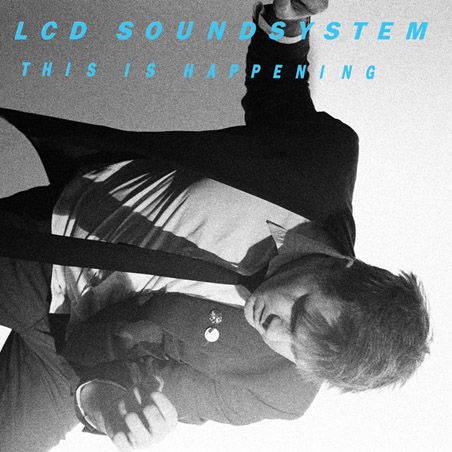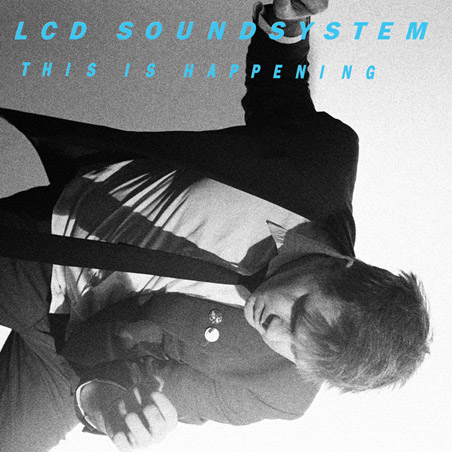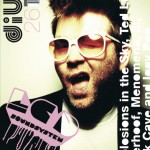Photos by Ruvan Wijesooriya
By Aaron Richter
I first met Ruvan Wijesooriya just a short while after I’d moved to New York; we were assigned to cover, of all bands, the Bravery recording their second album. At the time, I was familiar with Ruvan’s work–chronicling the city’s nightlife on film (always on film), and steadily emerging as a talented fashion and music photographer as well. We’ve remained friends ever since, always lending a hand to each other’s projects.
So I’ll be the first to admit I was sickly jealous when I got an e-mail from him this past summer saying that he was partying in Laurel Canyon, California, at the Mansion (yes, Rick Rubin’s Mansion) where James Murphy was recording the new LCD Soundsystem album. Ruvan has been a visual presence with DFA for years, and the cover of LCD’s latest, This Is Happening, features one of his images.
Since James & Co. are performing at Webster Hall tonight (two new tracks also just popped up online), I caught up with Ruvan to chat about his summer with LCD…

self-titled: What do you like about the shot that LCD used for the cover?
I like that its grainy, black and white and not right side up, but not upside down.
How have you been involved with DFA throughout the years, and how did you come to be spending time with the band while James was recording?
In 2005, I met James briefly at the Miami Winter Music Conference. The [self-titled] LCD album was one of my favorites that year, so after going to some DFA party and taking some photos, I sent in a shot of someone reaching up for a disco ball that I thought would be cool for a cover of a single. They had already picked out the cover for the last single (“Disco Infiltrator”) from that album, so they made my photo into a poster that came with the 7-inch. [Ruvan has signed, limited-edition prints of this image available for purchase. E-mail him for info.] Since then, James had me come in and shoot their press photos. I’ve also shot loads of other DFA acts as well. James also wrote the intro to my book, ALL NIGHT NEW YORK.
Anyhow, five years later, when recording the third album, he asked me to come out, stay with them, shoot some photos, bring my weirdness. I remember I got the text as I landed on a plane coming from Copenhagen, so it was back-to-back adventures. I think he also wanted me around since I’m a bit of an instigator. He’s comfortable with how I can make things slightly uncomfortable when they are too comfy–but also comfortable when things are too uncomfy. Being that James is kind of a curator of people, I’m sure he knew the role I would fall into once I was in the mix.
How would you describe the Mansion?
The Mansion (some call it “Manshun”) is this fucking amazing place in the Hollywood Hills, where it feels like you could be anywhere warm in the world–Brazil, Spain, the Hollywood Hills, yo. There’s nothing very “L.A.†about it since the place is covered with trees and somewhat hidden. There’s tons of rooms there, and the history of the place is epic. Slayer and the Red Hot Chili Peppers, among many, have recorded there. Frank Zappa lives around the corner. Maroon 5 is jamming across the street (not that I get a boner for that, but its notable). Important, too, is the history of Laurel Canyon. Some people say the Beatles tripped for the first time at the Mansion. There’s a whole lot of random, crazy shit that place has seen. Some say the place is haunted by a gay ghost, and I don’t disbelieve it. It’s no fancy mansion, and it is falling apart at the seams–a rock ‘n’ roll Grey Gardens, if you will.
The vibe was incredible when I was there. The day I arrived on trip one of two, they had just completed making the studio space, which was incredible–so many synths, endless cowbells, incredible for recording–a custom operation. They were finishing the Franz Ferdinand cover, “Live Alone‖a great cover song, I thought. During that first visit, we really went for it any chance we could get. The album was in the initial stages of concept, or so it seemed. There was a rotating cast of characters who were staying there or even crashing for a night–Justine D., Nathan [Howdeshell] from the Gossip, etc. Other locals or transplants would join or stop by: Thorunn Antonia, Dirty Dave, Nigel Godrich, Busy P, Aziz Ansari, etc. I met all these comedians and shit; it was cool.
We tore L.A. a new asshole every time we went out. We out-douche-bagged the douche bags; we made a point to be “so L.A.” James and crew would show up at the club in all-white outfits whenever anyone at the Mansion had a DJ gig. We’d try and convince promoters to send Hummer limos with enough cheap champagne to give an elephant a hangover. It didn’t happen as often as we would have liked. However, with enough bourbon and Andre, you can convince yourself that a shitty, beat-up black limo is a white Hummer. It was always best when nobody had the responsibility of driving. One of the many sayings I left with was “Driving to the bar is like running through a burning house with a keg of gunpowder.†Such an L.A. thing to do, unfortunately.
After staying out late, dancing like banshees and whatnot, we’d come home. Some nights we’d all just go to bed. Occasionally me and some of the troopers would have a late-night swim party. Sometimes James would come back, and it would get quiet. I’d stand outside his room armed with a camera and jump in to take a shot really quick and as unobtrusive as possible. It was amazing to hear his piano tinkering become a song a few days later. Truly a pleasure.
You probably shot a lot while you stayed there. Do you remember taking the cover photo?
The only album art I shot in L.A. was for [LCD’s Alan Vega cover] “Bye Bye Bayou,” which is just so badass–technically and artistically speaking: [On that cover] Pat Mahoney is some sort of lovechild of a Vietnam vet and a Cockette (as in, the sexual anarcho-communists from San Francisco in the hippie days) on a mushroom trip into outer space. The album art for the This Is Happening cover was less dream, more punch.
The This Is Happening shot was done in my studio on West 39th Street–much cleaner, less experimental and somehow more referential to the album as a whole, as well as James’ state of being after just having completed the recordings. You see, he is a bit turned around, not knowing which side is up, yet still confident and moving forward.
His pose and styling recall Robert Longo. Was that intentional?
With the work I do for James and LCD, I want most everything to look reminiscent and [the photos] should make people feel nostalgic for a past they have never experienced. I think a lot of my work desires to create this feeling, to capture a moment, a motion, an emotion, something of substance–it is why I shoot film as much as I can.
Robert Longo’s “Men in the Cities†artwork is ubiquitous at this point–easy for the public to understand because it is constantly referenced. I believe the last time I saw his work, it was in the lobby of a museum, the Met, maybe. That said, it’s well known, communicates with a broad audience and is fantastic artwork. Any image with a suit and a fucking skinny tie automatically conjures up those works of Longo. My reference wasn’t as intentional as it was unavoidable. When we were shooting this, we were both like, “Okay, we have the skinny tie and the suit; lets go with the Longo reference.” However, there’s other ’70s references in there that I feel are as present, such as Derek Boshier’s cover for Bowie’s Lodger album–the graininess of the 3200-speed film, the upside-down, turned-around thing. The other shot I really liked for the cover was very Smiths-y. Hopefully they’ll do T-shirts with that picture.
How is James as a model?
James is one of the most particular guys I know. He’s full of ideas and is a pleasure to collaborate with, obviously from our history. Shooting him is tricky for loads of reasons–the same reasons it is tricky shooting anyone who isn’t 18 and in love with the camera. I will say that much like everyone else I shoot, we get tons more done when it’s just me and the subject. The productivity goes through the roof the minute everyone else in the room leaves.
How did living and working at the Mansion affect your work while you were there?
It was a great experience I could never have even dreamed up. The style of shooting when I was living at the Mansion was something I had already developed and established within myself, so that was nothing new at all. Living and shooting at the Mansion meant there were no rules for me to adhere to artistically except my own. There was no formality to any of the shots taken at the Mansion; they were all in the moment, all reactionary, experimental and for a laugh. James had me shoot photos for myself because he knows those are gonna be the most honest, the funniest and beautiful–instant memories. James knows I’m obsessive about taking pictures, so all he had to do was get me out there. When he got me out the second time to shoot the “Bye Bye Bayou†cover, it was slightly different because there was a goal. It wasn’t making or capturing memories, personality or a true moment.
 On the other hand, the relationships from the Mansion have had a huge effect on my work–my cover for Aziz Ansari, my still photos of Ed Ruscha for Doug Aitken and other bits of my work here–and they were related to my presence at the Mansion. At the end of the day, I have taught myself to take pictures I like, and photography has become a visual understanding of my relationship to the world and others.
Based on what you’ve heard, what do you think of This Is Happening?
I’ve heard the album several times in various stages–with lyrics, instrumental, finals, demos, etc. Everything sounds better now than it did when they were demos. I think everyone knows James is a freak show of a producer. He holds himself to extremely rigid standards; I only know a few others who are as knowledgeable and hardcore about recording. On the lyrical and melodic side, LCD has this amazing way of making me question things. There’s a song where the lyrics go, “I can change I can change I can change…†and so on. I won’t compare it to “All My Friends,†but if there’s a song that will make me wonder if I should be crying or dancing, I get the feeling it is that song. The entire album–much like the artwork–should also conjure up nostalgia for music you probably didn’t grow up with.


